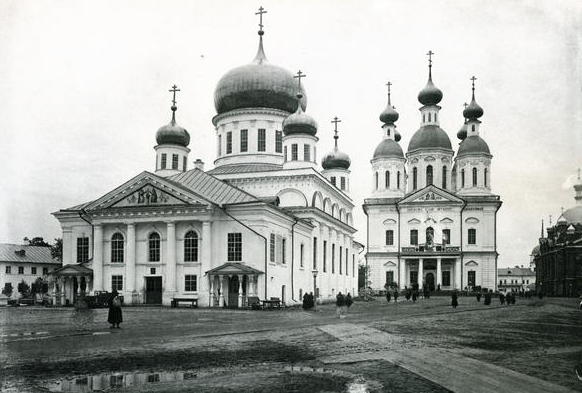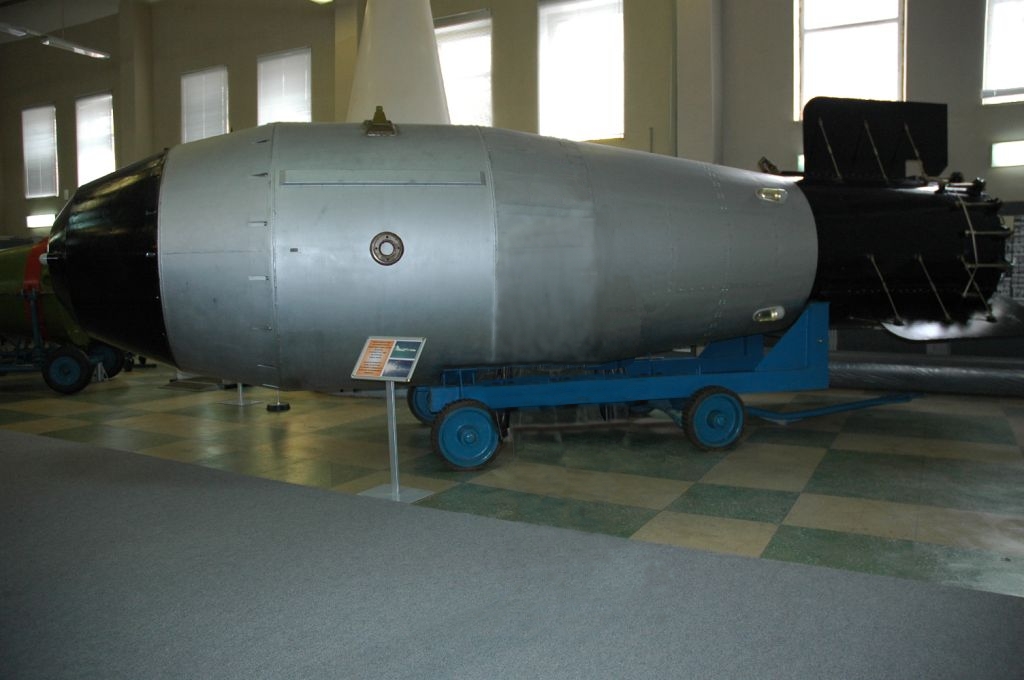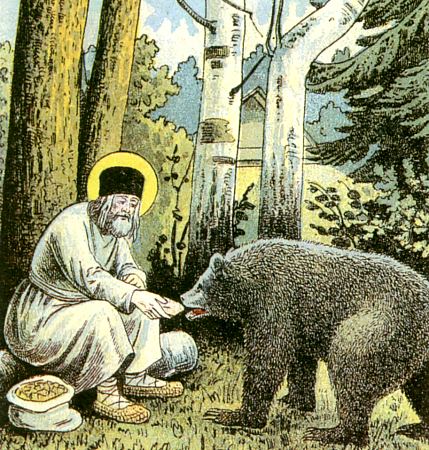|
Sarov Monastery
The Monastery of the Dormition of the Mother of God (Russian: ''Свято-Успенская Саровская пустынь'') is located in Sarov, Russia. The town took its name from being the site of the monastery, next to the Sarov River. In 1664, an Orthodox monk Theodosius first settled on the Sarov hill. The monastery was established for monks in 1706. The hermit and mystic Saint Seraphim of Sarov, one of the most venerated saints of the Russian Orthodox church, was living in Sarov from 1778 to 1833. In 1903, the monastery was visited by Tsar Nicholas II and other members of the imperial family. At that time the monastery had nine churches, including one underground. Around 320 monks lived in the monastery. In 1927, the monastery was closed, the monks faced Bolshevik repressions, and many were executed. During World War II, the monastery buildings were used as factories for producing rockets for BM-13 "Katyusha" rocket launchers. It was reactivated in 2006 and reconstr ... [...More Info...] [...Related Items...] OR: [Wikipedia] [Google] [Baidu] |
Sarov
Sarov (russian: Саро́в) is a closed town in Nizhny Novgorod Oblast, Russia. It was known as Gorkiy-130 (Горький-130) and Arzamas-16 (), after a (somewhat) nearby town of Arzamas,SarovLabsCreation of Nuclear Center Arzamas-16/ref> from 1946 to 1991. Until 1995, it was known as Kremlyov/Kremlev/Kremljov (). The town is closed as it is the Russian center for nuclear research. Population: 92,047 ( 2010 Census); 87,652 ( 2002 Census) History The history of the town can be divided into two different periods. In the earlier history of Russia it was known as one of the holy places of the Russian Orthodox Church, because of its monastery, that gave Russia one of its greatest saints, St. Seraphim. Since the 1940s, it has gradually become the center for research and production of Soviet and later Russian nuclear weapons. The history of human settlement in the area around Sarov goes back at least to the 12th–13th centuries, when a large Mordvin settlement was foun ... [...More Info...] [...Related Items...] OR: [Wikipedia] [Google] [Baidu] |
Sarov River
Sarov (russian: Саро́в) is a closed city, closed town in Nizhny Novgorod Oblast, Russia. It was known as Gorkiy-130 (Горький-130) and Arzamas-16 (), after a (somewhat) nearby town of Arzamas,SarovLabsCreation of Nuclear Center Arzamas-16/ref> from 1946 to 1991. Until 1995, it was known as Kremlyov/Kremlev/Kremljov (). The town is closed as it is the Russian center for nuclear research. Population: 92,047 (Russian Census (2010), 2010 Census); 87,652 (Russian Census (2002), 2002 Census) History The history of the town can be divided into two different periods. In the earlier history of Russia it was known as one of the holy places of the Russian Orthodox Church, because of its monastery, that gave Russia one of its greatest saints, Saint Seraphim of Sarov, St. Seraphim. Since the 1940s, it has gradually become the center for research and production of Soviet and later Russian nuclear weapons. The history of human settlement in the area around Sarov goes bac ... [...More Info...] [...Related Items...] OR: [Wikipedia] [Google] [Baidu] |
Saint Seraphim Of Sarov
Seraphim of Sarov (russian: Серафим Саровский; – ), born Prókhor Isídorovich Moshnín (Mashnín) �ро́хор Иси́дорович Мошни́н (Машни́н) is one of the most renowned Russian saints and is venerated in the Eastern Orthodox Church. He is generally considered the greatest of the 18th-century ''startsy'' (elders). Seraphim extended the monastic teachings of contemplation, theoria and self-denial to the layperson. He taught that the purpose of the Christian life was to receive the Holy Spirit. Perhaps his most popular quotation amongst his devotees is "acquire a peaceful spirit, and thousands around you will be saved." Seraphim was glorified by the Russian Orthodox Church in 1903. Life Born 19 July (O.S.) 1754, Seraphim was baptized with the name of Prochor, after Prochorus, one of the first Seven Deacons of the Early Church and the disciple of John the Evangelist. His parents, Isidore and Agathia Moshnin, lived in Kursk, Russi ... [...More Info...] [...Related Items...] OR: [Wikipedia] [Google] [Baidu] |
Nicholas II
Nicholas II or Nikolai II Alexandrovich Romanov; spelled in pre-revolutionary script. ( 186817 July 1918), known in the Russian Orthodox Church as Saint Nicholas the Passion-Bearer,. was the last Emperor of Russia, King of Congress Poland and Grand Duke of Finland, ruling from 1 November 1894 until his abdication on 15 March 1917. During his reign, Nicholas gave support to the economic and political reforms promoted by his prime ministers, Sergei Witte and Pyotr Stolypin. He advocated modernization based on foreign loans and close ties with France, but resisted giving the new parliament (the Duma) major roles. Ultimately, progress was undermined by Nicholas's commitment to autocratic rule, strong aristocratic opposition and defeats sustained by the Russian military in the Russo-Japanese War and World War I. By March 1917, public support for Nicholas had collapsed and he was forced to abdicate the throne, thereby ending the Romanov dynasty's 304-year rule of Russia (16 ... [...More Info...] [...Related Items...] OR: [Wikipedia] [Google] [Baidu] |
Katyusha Rocket Launcher
The Katyusha ( rus, Катю́ша, p=kɐˈtʲuʂə, a=Ru-Катюша.ogg) is a type of rocket artillery first built and fielded by the Soviet Union in World War II. Multiple rocket launchers such as these deliver explosives to a target area more intensively than conventional artillery, but with lower accuracy and requiring a longer time to reload. They are fragile compared to artillery guns, but are cheap, easy to produce, and usable on almost any chassis. The Katyushas of World War II, the first self-propelled artillery mass-produced by the Soviet Union,Zaloga, p 150. were usually mounted on ordinary trucks. This mobility gave the Katyusha, and other self-propelled artillery, another advantage: being able to deliver a large blow all at once, and then move before being located and attacked with counter-battery fire. Katyusha weapons of World War II included the BM-13 launcher, light BM-8, and heavy BM-31. Today, the nickname ''Katyusha'' is also applied to newer truck-mounte ... [...More Info...] [...Related Items...] OR: [Wikipedia] [Google] [Baidu] |
Russian Orthodox Church
, native_name_lang = ru , image = Moscow July 2011-7a.jpg , imagewidth = , alt = , caption = Cathedral of Christ the Saviour in Moscow, Russia , abbreviation = ROC , type = , main_classification = Eastern Orthodox , orientation = Russian Orthodoxy , scripture = Elizabeth Bible ( Church Slavonic) Synodal Bible (Russian) , theology = Eastern Orthodox theology , polity = Episcopal , governance = Holy Synod of the Russian Orthodox Church , structure = Communion , leader_title = , leader_name = , leader_title1 = Primate , leader_name1 = Patriarch Kirill of Moscow , leader_title2 = , leader_name2 = , leader_title3 = Bishops , leader_name3 = 382 (2019) , fellowships_type = Clergy , fellowships = 40,514 full-time clerics, including 35,677 presbyters and 4,837 de ... [...More Info...] [...Related Items...] OR: [Wikipedia] [Google] [Baidu] |
Nizhny Novgorod
Nizhny Novgorod ( ; rus, links=no, Нижний Новгород, a=Ru-Nizhny Novgorod.ogg, p=ˈnʲiʐnʲɪj ˈnovɡərət ), colloquially shortened to Nizhny, from the 13th to the 17th century Novgorod of the Lower Land, formerly known as Gorky (, ; 1932–1990), is the administrative centre of Nizhny Novgorod Oblast and the Volga Federal District. The city is located at the confluence of the Oka and the Volga rivers in Central Russia, with a population of over 1.2 million residents, up to roughly 1.7 million residents in the urban agglomeration. Nizhny Novgorod is the sixth-largest city in Russia, the second-most populous city on the Volga, as well as the Volga Federal District. It is an important economic, transportation, scientific, educational and cultural center in Russia and the vast Volga-Vyatka economic region, and is the main center of river tourism in Russia. In the historic part of the city there are many universities, theaters, museums and churches. The city w ... [...More Info...] [...Related Items...] OR: [Wikipedia] [Google] [Baidu] |
Russian Orthodox Monasteries In Russia
Russian(s) refers to anything related to Russia, including: *Russians (, ''russkiye''), an ethnic group of the East Slavic peoples, primarily living in Russia and neighboring countries *Rossiyane (), Russian language term for all citizens and people of Russia, regardless of ethnicity *Russophone, Russian-speaking person (, ''russkogovoryashchy'', ''russkoyazychny'') *Russian language, the most widely spoken of the Slavic languages *Russian alphabet *Russian cuisine *Russian culture *Russian studies Russian may also refer to: *Russian dressing *''The Russians'', a book by Hedrick Smith *Russian (comics), fictional Marvel Comics supervillain from ''The Punisher'' series *Russian (solitaire), a card game * "Russians" (song), from the album ''The Dream of the Blue Turtles'' by Sting *"Russian", from the album ''Tubular Bells 2003'' by Mike Oldfield *"Russian", from the album '' '' by Caravan Palace *Nik Russian, the perpetrator of a con committed in 2002 *The South African name for a ... [...More Info...] [...Related Items...] OR: [Wikipedia] [Google] [Baidu] |
Cultural Heritage Monuments Of Federal Significance In Nizhny Novgorod Oblast
Culture () is an umbrella term which encompasses the social behavior, institutions, and norms found in human societies, as well as the knowledge, beliefs, arts, laws, customs, capabilities, and habits of the individuals in these groups.Tylor, Edward. (1871). Primitive Culture. Vol 1. New York: J.P. Putnam's Son Culture is often originated from or attributed to a specific region or location. Humans acquire culture through the learning processes of enculturation and socialization, which is shown by the diversity of cultures across societies. A cultural norm codifies acceptable conduct in society; it serves as a guideline for behavior, dress, language, and demeanor in a situation, which serves as a template for expectations in a social group. Accepting only a monoculture in a social group can bear risks, just as a single species can wither in the face of environmental change, for lack of functional responses to the change. Thus in military culture, valor is counted a typical be ... [...More Info...] [...Related Items...] OR: [Wikipedia] [Google] [Baidu] |






